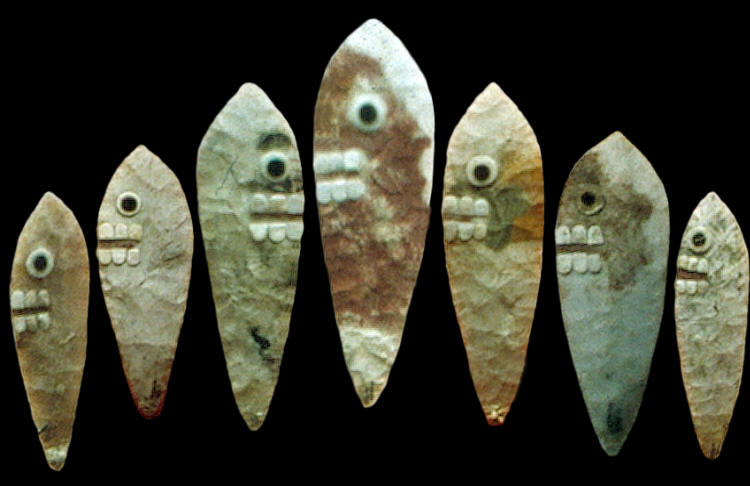|
"PERSONIFIED"
AZTEC BIFACES
KNOWN AS
TECPATL CEREMONIAL KNIVES AND AZTEC SACRIFICIAL KNIVES
MEXICO CITY
LATE PRECLASSIC PERIOD
A.D. 1175 TO 1521
PICTURE IMAGES TAKEN FROM LITHIC CASTING LABS COLLECTION OF ORIGINAL
SLIDE IMAGES
GO TO AZTEC BIFACES
ARTICLE FOR MORE
The Aztec bifaces in this picture were discovered during the
excavation of the Great
Aztec Temple (axis mundi, the navel of the Aztec universe) in Mexico
city.
All of these examples have
been "dressed" or "personified" with teeth and eyes made of shell
and pupils made of either obsidian or hematite. Eyebrows were also
sometimes applied with small pieces of turquoise and the blade
surfaces painted with different designs.
The archaeological record shows that most Aztec bifaces were used in
ceremonial applications and
represent an important part of Aztec mythology. Images of Aztec
bifaces were carved in stone in the form of glyphs and drawn as
illustrations in manuscripts. In the Aztec ritual calendar, they
represent a day called "flint knife," who represents the Aztec
god, Tezcatlipoca. He is one of the most powerful and influential
Aztec gods who is associated with temptation, destruction and
rebirth. This god wears a tiger skin (ocelot) and an obsidian blade
which represents the cold, black, biting winds of the north.
Tezcatlipoca literally means smoking mirror. He is shown wearing a
smoking obsidian mirror on his head and one in the place of one of
his feet. This peculiar weapon gave off smoke that killed his
enemies.
Aztec bifaces, like the examples in this picture, are directly
connected with those illustrated in the codices and stone engravings
that represent complex Aztec religions mythology.

|
